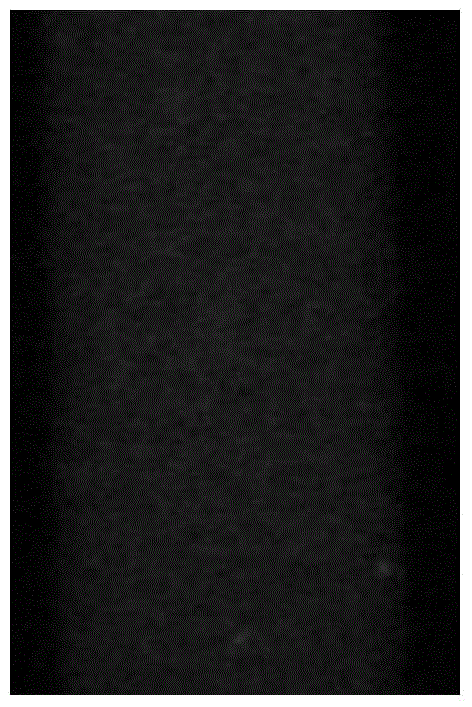Cellulose 6-aminocaproate and its synthesis method and application
A technology of aminocaproic acid and cellulose ester, applied in coating and other directions, can solve the problems of high viscosity of solution, inconvenient experimental operation, unsatisfactory effect of inhibiting non-specific adsorption of proteins, etc., and achieves low cost, wide source, inhibition of non-specific The effect of adsorption
- Summary
- Abstract
- Description
- Claims
- Application Information
AI Technical Summary
Problems solved by technology
Method used
Image
Examples
Embodiment 1
[0029] 1. Synthesis of N-tert-butoxycarbonyl-6-aminocaproic acid
[0030] Add 1.60 (40 mmol) sodium hydroxide, 2.62 g (20 mmol) 6-aminocaproic acid, 4.37 g (20 mmol) di-tert-butyl dicarbonate, 10 mL distilled water, 10 mL 1,4- Dioxane, stirred at -10°C for 10 hours, after the reaction, slowly pour the reaction solution into a 100mL beaker, acidify the reaction solution with aqueous hydrochloric acid solution with a concentration of 2mmol / L to pH 2, and use ethyl acetate Repeated extraction of the resulting product 3 times, collecting the ethyl acetate extract, drying the ethyl acetate extract with anhydrous sodium sulfate, then evaporating and concentrating the ethyl acetate extract, adding petroleum ether to the concentrated extract for recrystallization, filtering, About 4.3 g of N-tert-butoxycarbonyl-6-aminocaproic acid was obtained as a white crystalline solid.
[0031] 2. N,N'-carbonyldiimidazole activates N-tert-butoxycarbonyl-6-aminocaproic acid
[0032] Add 4.27 g (1...
Embodiment 2
[0039]In the synthesis of N-tert-butoxycarbonyl-6-aminocaproic acid cellulose ester step 3 in Example 1, the fiber is taken according to the molar ratio of cellulose and N-tert-butoxycarbonyl-6-aminocaproic acid as 1:4 Element, dissolving cellulose and tetrabutylammonium fluoride trihydrate in dimethyl sulfoxide in a mass ratio of 1:6, reacting at room temperature under nitrogen protection for 15 minutes, pouring into the reaction solution obtained in step 2, and Under the protection of nitrogen, react at 50°C for 25 hours, precipitate the precipitate with ultrapure water, filter, and wash the precipitate with ethanol to obtain N-tert-butoxycarbonyl-6-aminocaproic acid cellulose. The other steps were the same as in Example 1 to obtain cellulose 6-aminocaproate, and the total average degree of substitution (DS) was calculated to be 0.72.
Embodiment 3
[0041] In the synthesis of N-tert-butoxycarbonyl-6-aminocaproic acid cellulose ester step 3 in Example 1, take the fiber according to the molar ratio of cellulose and N-tert-butoxycarbonyl-6-aminocaproic acid as 1:5 Element, dissolving cellulose and tetrabutylammonium fluoride trihydrate in dimethyl sulfoxide in a mass ratio of 1:6, reacting at room temperature under nitrogen protection for 15 minutes, pouring into the reaction solution obtained in step 2, and Under the protection of nitrogen, react at 90°C for 18 hours, precipitate the precipitate with ultrapure water, filter, and wash the precipitate with ethanol to obtain N-tert-butoxycarbonyl-6-aminocaproic acid cellulose ester. The other steps were the same as in Example 1 to obtain cellulose 6-aminocaproate, the total average degree of substitution (DS) of which was calculated to be 0.93.
PUM
 Login to View More
Login to View More Abstract
Description
Claims
Application Information
 Login to View More
Login to View More - R&D
- Intellectual Property
- Life Sciences
- Materials
- Tech Scout
- Unparalleled Data Quality
- Higher Quality Content
- 60% Fewer Hallucinations
Browse by: Latest US Patents, China's latest patents, Technical Efficacy Thesaurus, Application Domain, Technology Topic, Popular Technical Reports.
© 2025 PatSnap. All rights reserved.Legal|Privacy policy|Modern Slavery Act Transparency Statement|Sitemap|About US| Contact US: help@patsnap.com



